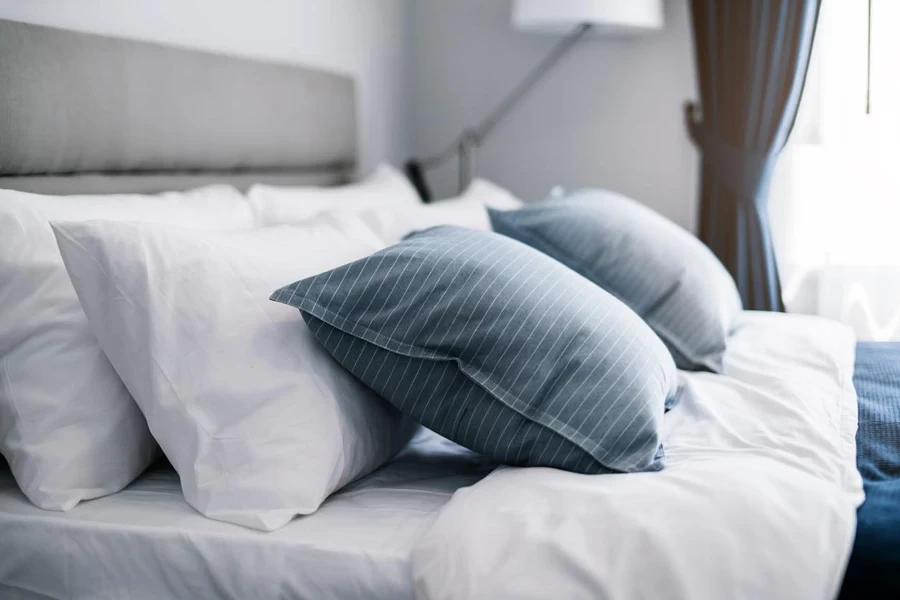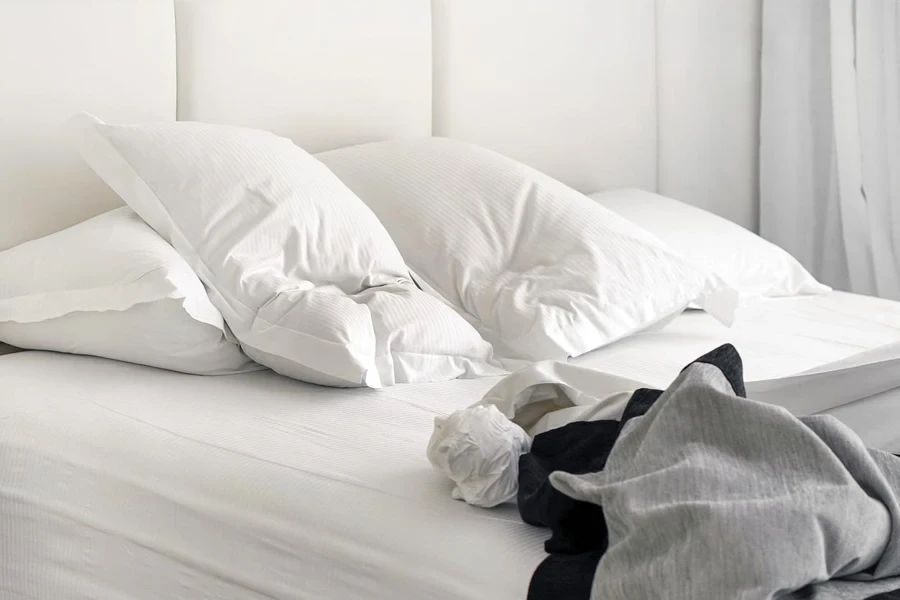In the quest for a perfect night’s sleep, selecting the right bed pillow emerges as a pivotal decision for both health and comfort. The landscape of bed pillows is rapidly evolving, with innovations aiming to enhance sleep quality through ergonomic designs and advanced materials. As 2024 approaches, consumers and retailers alike are witnessing a significant shift towards pillows that not only promise comfort but also cater to specific health needs and personal preferences. This shift underscores the importance of staying abreast of the latest trends and features in bed pillows. Understanding these changes is crucial for making informed choices that align with individual needs and market demands.
Table of Contents:
1. Market overview
2. Different types and their features
3. Things to consider when selecting products
1. Market overview
The global sleeping pillow market is poised for dynamic growth in the coming years. According to a report, this market is projected to expand at an impressive Compound Annual Growth Rate (CAGR) of 7.3% from 2022 to 2028. In 2021, the market was valued at approximately USD 15,990 million and is anticipated to reach around USD 26,340 million by 2028. This significant growth can be attributed to various factors, including the increasing awareness of sleep quality and the evolving consumer preference towards health and comfort.

Key players dominating the market include Hollander, Wendre, MyPillow, and Tempur Sealy, collectively holding a substantial market share. Notably, the top two manufacturers, Hollander and John Cotton, command about 38% of the market. The Asia Pacific region leads in terms of consumption, accounting for about 68% of the global market, driven by rising consumer awareness and a growing middle class with increasing purchasing power.
The market is witnessing a shift in consumer preferences, with a growing demand for ergonomic and hypoallergenic pillows. Products made from wool/cotton, memory foam, latex, down/feather, and polyester are seeing increased adoption. Residential applications lead the market, followed closely by the hotel and hospital sectors. This shift is indicative of a broader trend towards personal health and wellness, where consumers are seeking products that not only provide comfort but also align with their health-conscious lifestyles.

2. Different types and their features
In the diverse world of bed pillows, several types stand out in 2024, each offering unique benefits to cater to varied consumer needs.
Adjustable memory foam pillows: These pillows, exemplified by the Saybrook Adjustable Pillow and Coop Home Goods Eden Pillow, offer unmatched versatility and customizability. Users can adjust the loft and firmness to their preference, making them suitable for a wide range of sleep positions. According to the product descriptions, the Saybrook Pillow’s filling is firm yet comfortable, supporting the head while maintaining softness. The Coop Home Goods Eden Pillow, on the other hand, leans towards a softer filling with a high proportion of polyfiber, providing a plush sleeping experience. These adjustable pillows are particularly appealing for their ability to cater to individual comfort needs, whether one prefers a flatter or a loftier pillow.
Latex pillows: The Saatva Latex Pillow is a prime example of the benefits offered by latex pillows. Latex is known for its supportive and durable nature, providing a resilient yet comfortable surface for sleepers. It’s responsive, meaning it contours to the shape of the head and neck, yet springs back to its original shape. This combination of contouring and support makes latex pillows a favorite among those seeking a balance between softness and structural support.

Down and down-alternative pillows: Traditional down pillows, such as the Brooklinen Down Pillow, offer classic comfort known for its softness and luxury. Down pillows are light, fluffy, and excellent for those who prefer a pillow they can sink into. However, for those with allergies or ethical concerns, down-alternative pillows provide a hypoallergenic and cruelty-free option. These alternatives mimic the feel of down but use synthetic materials, making them more accessible to a wider range of users.
Specialized pillows for neck and back support: Pillows like the Layla Kapok Pillow address specific needs such as neck and back support. This pillow combines shredded memory foam with fibers from the Kapok tree, offering a balance between softness and support. The adjustable nature allows users to add or remove filling to achieve the desired level of firmness, catering specifically to those who need extra support to maintain spinal alignment or alleviate neck pain.

3. Things to consider when selecting products
When selecting the ideal bed pillows for 2024, several critical factors must be considered to ensure the products meet the diverse needs and preferences of consumers.
Adjustability and customization: The ability to adjust loft and fill is crucial for personalized comfort in bed pillows. Adjustable pillows, like the Saybrook Adjustable Pillow and Coop Home Goods Eden Pillow, allow users to modify the level of support and firmness to their liking. This feature is particularly beneficial for those whose comfort needs may change over time or who have specific preferences that standard pillows cannot meet. The adaptability of these pillows makes them a versatile choice for a wide range of sleeping positions and personal comfort levels.
Material quality and hypoallergenic properties: The choice of materials in pillows significantly impacts their durability, comfort, and suitability for people with allergies. For instance, the Saatva Latex Pillow, made of high-quality latex, is known for its durability and supportive nature. On the other hand, down-alternative pillows, such as those offered by Brooklinen, provide hypoallergenic benefits, making them a safer choice for allergy sufferers. The selection of high-quality, hypoallergenic materials ensures that pillows not only offer comfort but also cater to health and wellness needs.

Sleep position and ergonomic support: Selecting a pillow based on sleep position is essential for maintaining proper neck and spinal alignment. Side sleepers generally require a higher loft to fill the gap between their head and shoulder, while back sleepers may prefer a medium loft for adequate support. Stomach sleepers often benefit from a lower loft to avoid neck strain. Ergonomic pillows like the Layla Kapok Pillow are designed to cater to these specific needs, providing targeted support that can help prevent pain and discomfort.
Temperature regulation and breathability: For hot sleepers, the importance of cooling features and breathability in pillows cannot be overstated. Pillows with breathable materials and cooling technologies help regulate temperature throughout the night, providing a comfortable sleep experience. For example, memory foam pillows infused with cooling gels or those with breathable covers, like the ones from Coop Home Goods, can significantly improve sleep quality for those who tend to overheat.

Conclusion
The right pillow choice is more than just a matter of comfort; it’s a crucial factor in enhancing overall sleep quality and, consequently, well-being. As we have explored, considerations such as adjustability, material quality, alignment with sleep positions, and breathability play significant roles in this choice. For retailers and individual consumers alike, mindful consideration of these aspects can lead to selections that not only promise comfort but also contribute to healthier, more restful sleep. It’s clear that in the dynamic world of bed pillows, the right choice can make all the difference in unlocking the secret to a good night’s sleep.




